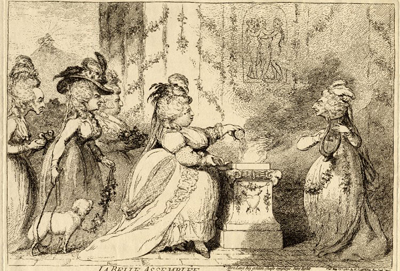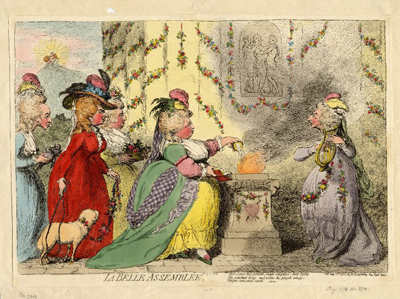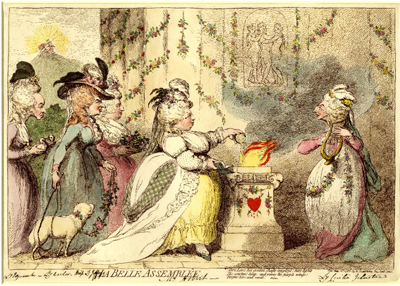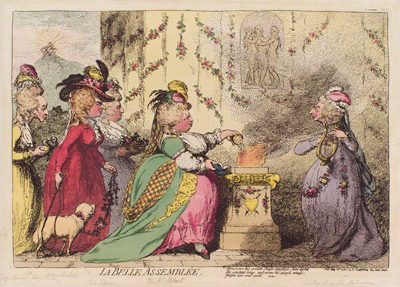Gillray's Techniques

© Trustees of the British Museum
Coloring
Many of Gillray's prints survive in both colored and uncolored versions. Uncolored prints were always cheaper than the colored versions, and were also more common, at least early in Gillray's career. The colored versions were hand-painted in beautiful inks and water-colors by members of the print-seller's staff after a model usually provided (we are told) by the artist himself. But once you begin to look at Gillrays across multiple archives, you can't miss the fact that the coloring of prints can differ markedly, and not simply because they have faded over time.
One possible explanation is that Gillray provided more than one model, providing multiple color-schemes to attract buyers of different tastes. Another is that a print was requested and produced when Gillray was no longer alive or the original model was unavailable. We know, for instance, that George Humphrey was producing collections of Gillray's works for patrons nearly five years after Gillray's death.

© Trustees of the British Museum
I suspect that both explanations could be true for any given print. One would need to compare versions from multiple archives to make an educated guess at the original master color or to demonstrate that one print was clearly prior based on other evidence.
La Belle Assemblee [1787] is an excellent case in point. First we have the uncolored version where we can see how far Gillray has come since his prints of 1783. Perhaps because Gillray is parodying the combination of history painting and portraiture championed by Sir Joshua Reynolds, there is exquisite attention to detail in the dresses, hats, and flowers. The backgrounds, the figures are all fully realized. And there is great subtlety in the variation of shading using a combination of etching, engraving, and aquatint.
The colored versions of the print vary considerably. The three figures on the left—the Countess Mount-Edgcumbe, Lady Sarah Archer, and Elizabeth Jeffries—have recognizably different colored dresses in each print.

© Trustees of the British Museum
And even the central figure of Mrs. Hobart and the lyre-playing Lady Cecilia Johnston, though more similar in coloring, have significant variations in at least two of the three versions.
If I had to hazard a guess as to which of the three colored versions was Gillray's "model," I would probably say the last version from the National Portrait Gallery. For although Gillray's prints are full of discordant and outrageous action, the forms in his mature work are wonderfully integrated and the colors are similarly balanced. He would not have allowed the dominating red of Lady Archer's dress or the glaring yellow of Mrs Hobart's dress in the first colored version or the stark black in the hats of the second colored version.
NOTE: In a private conversation at his shop, Andrew Edmunds indicated to me that he strongly disagrees with my "guess." here.

© National Portrait Gallery
Proof, one way or another, would require looking at (among other things) the type of paper (laid vs. wove), any watermark on the print copy, the stamp of a collectors, or other evidence which could shed light upon the date of the print run. To my knowledge, this non-trivial task has yet to be embarked upon in any systematic way.